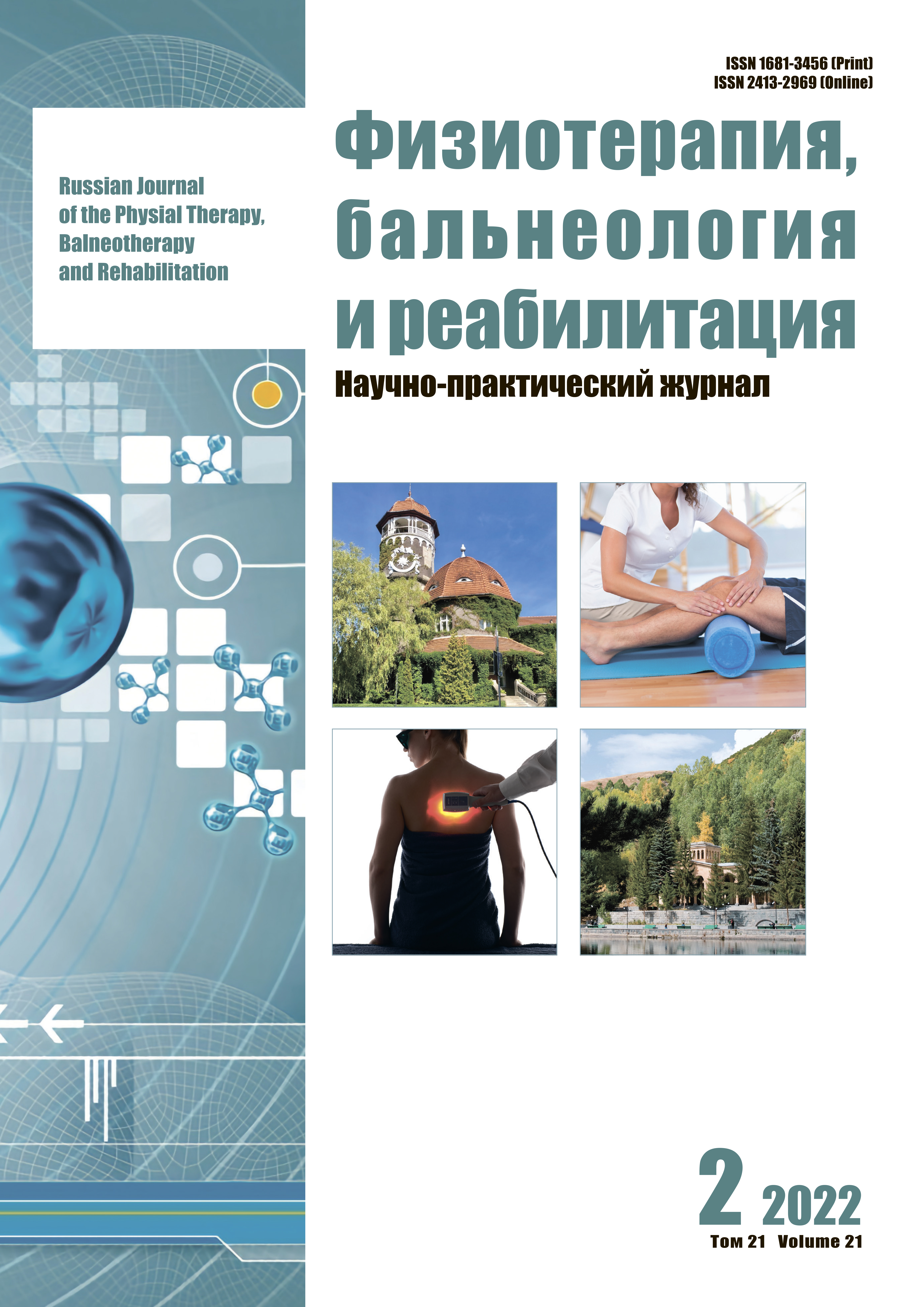Efficacy of transcutaneous electrical nerve stimulation in the treatment of a patient with amyotrophic lateral sclerosis due to syringomyelia
- Authors: Al-Zamil M.K.1, Kulikova N.G.1,2, Vasilieva E.S.3
-
Affiliations:
- Peoples' Friendship University of Russia
- National Medical Research Center for Rehabilitation and Balneology
- Moscow State University of Medicine and Dentistry named after A.I. Evdokimova
- Issue: Vol 21, No 2 (2022)
- Pages: 143-158
- Section: Clinical notes and case reports
- Published: 03.12.2022
- URL: https://rjpbr.com/1681-3456/article/view/111885
- DOI: https://doi.org/10.17816/rjpbr111885
- ID: 111885
Cite item
Abstract
This paper demonstrates a clinical case of the development of amyotrophic lateral sclerosis with lesions of the anterior horns of the spinal cord in the cervicothoracic region against the background of syringomyelia.
The main complaints of the patient at the initial request for medical care were associated with weakness and hypotrophy of the right hand. Electrokymography revealed signs of damage to the anterior horns of the spinal cord at the C5–Th1 level with a predominant lesion of the motor fibers of the right median and ulnar nerves. As a result, a diagnosis of amyotrophic lateral sclerosis was made. Magnetic resonance imaging revealed the presence of Chiari I malformation and severe syringomyelia of the cervical and thoracic calving of the spinal cord.
The patient underwent surgical posterior decompression of the foramen magnum. However, the treatment was not effective with the worsening of the neurological deficit in the right hand and the spread of motor deficit and hypotrophy to the left hand.
After the use of transcutaneous electrical neurostimulation of the median and ulnar nerves, there was a significant regression of motor deficit with a decrease in the severity of malnutrition without significant changes in the electromyography parameters of the median and ulnar nerves.
The absence of neurological deficit in the lower extremities, with the preservation of tendon reflexes in the norm, and the absence of pathological reflexes, indicates a high plasticity of the pyramidal tracts at the level of the spinal cord.
Regression of motor deficit after the use of transcutaneous electrical nerve stimulation is due to improvement in the state of altered motor units with hypertrophy of muscle fibers and acceleration of reinnervation processes.
Full Text
About the authors
Mustafa Kh. Al-Zamil
Peoples' Friendship University of Russia
Author for correspondence.
Email: alzamil@mail.ru
ORCID iD: 0000-0002-3643-982X
SPIN-code: 3434-9150
MD, Dr. Sci. (Med.), Professor
Russian Federation, MoscowNatalia G. Kulikova
Peoples' Friendship University of Russia; National Medical Research Center for Rehabilitation and Balneology
Email: fbrmed@mail.ru
ORCID iD: 0000-0002-6895-0681
SPIN-code: 1827-7880
MD, Dr. Sci. (Med.), Professor
Congo, Moscow; MoscowEkaterina S. Vasilieva
Moscow State University of Medicine and Dentistry named after A.I. Evdokimova
Email: alzamil@mail.ru
ORCID iD: 0000-0003-3087-3067
SPIN-code: 5423-8408
MD, Dr. Sci. (Med.), Professor
Russian Federation, MoscowReferences
- Brickell KL, Anderson NE, Charleston AJ, et al. Ethnic differences in syringomyelia in New Zealand. J Neurol Neurosurg Psychiatry. 2006;77(8):989–991. doi: 10.1136/jnnp.2005.081240
- Sakushima K, Tsuboi S, Yabe I, et al. Nationwide survey on the epidemiology of syringomyelia in Japan. J Neurol Sci. 2012;313(1-2):147–152. doi: 10.1016/j.jns.2011.08.045
- Milhorat TH. Classification of syringomyelia. Neurosurg Focus. 2000;8(3):E1. doi: 10.3171/foc.2000.8.3.1
- Scivoletto G, Masciullo M, Pichiorri F, Molinari M. Silent post-traumatic syringomyelia and syringobulbia. Spinal Cord Ser Cases. 2020;6(1):15. doi: 10.1038/s41394-020-0264-y
- Foster JB. Neurology of syringomyelia. In: Batzdorf U, editor. Syringomyelia current concepts in diagnosis and treatment. Baltimore: Williams & Wilkins; 1991. Р. 91–115.
- Miyao Y, Sasaki M, Taketsuna S, et al. Early development of syringomyelia after spinal cord injury: case report and review of the literature. NMC Case Rep J. 2020;7(4):217–221. doi: 10.2176/nmccrj.cr.2019-0297
- Nakamura M, Ishii K, Watanabe K, et al. Clinical significance and prognosis of idiopathic syringomyelia. J Spinal Disord Tech. 2009;22(5):372–375. doi: 10.1097/BSD.0b013e3181761543
- Leclerc A, Matveeff L, Emery E. Syringomyelia and hydromyelia: current understanding and neurosurgical management. Rev Neurol (Paris). 2021;177(5):498–507. doi: 10.1016/j.neurol.2020.07.004
- Batzdorf U. Primary spinal syringomyelia. Invited submission from the joint section meeting on disorders of the spine and peripheral nerves. Review. J Neurosurg Spine. 2005;3(6):429–435.
- Moriwaka F, Tashiro K, Tachibana S, Yada K. Epidemiology of syringomyelia in Japan — the nationwide survey. Rinsho Shinkeigaku. 1995;35(12):1395–1397. (Japanese).
- Nagappan PG, Chen H, Wang DY. Neuroregeneration and plasticity: a review of the physiological mechanisms for achieving functional recovery postinjury. Mil Med Res. 2020;7(1):30. doi: 10.1186/s40779-020-00259-3
- Bogdanov EI, Heiss JD, Mendelevich EG, et al. Clinical and neuroimaging features of "idiopathic" syringomyelia. Neurology. 2004;62(5):791–794. doi: 10.1212/01.wnl.0000113746.47997.ce
- Bogdanov EI, Mendelevich EG, Khabibrakhmanov AN, et al. Clinical cases of amyotrophic lateral sclerosis concurrent with hydromyelia. Clin Case Rep. 2021;9(3):1571–1576. doi: 10.1002/ccr3.3832
- Hamada K, Sudoh K, Fukaura H, et al. An autopsy case of amyotrophic lateral sclerosis associated with cervical syringomyelia. No To Shinkei. 1990;42(6):527–531. (Japanese).
- Rafalowska J, Wasowicz B. Syringomyelia simulating amyotrophic lateral sclerosis. Pol Med J. 1968;7(5):1214–1218.
- Wijesekera LC, Nigel PL. Amyotrophic lateral sclerosis. Orphanet J Rare Dis. 2009;3(4):1–22.
- Rowland LP, Shneider NA. Amyotrophic lateral sclerosis. N Engl J Med. 2001;344(22):1688–1700. doi: 10.1056/NEJM200105313442207
Supplementary files

























